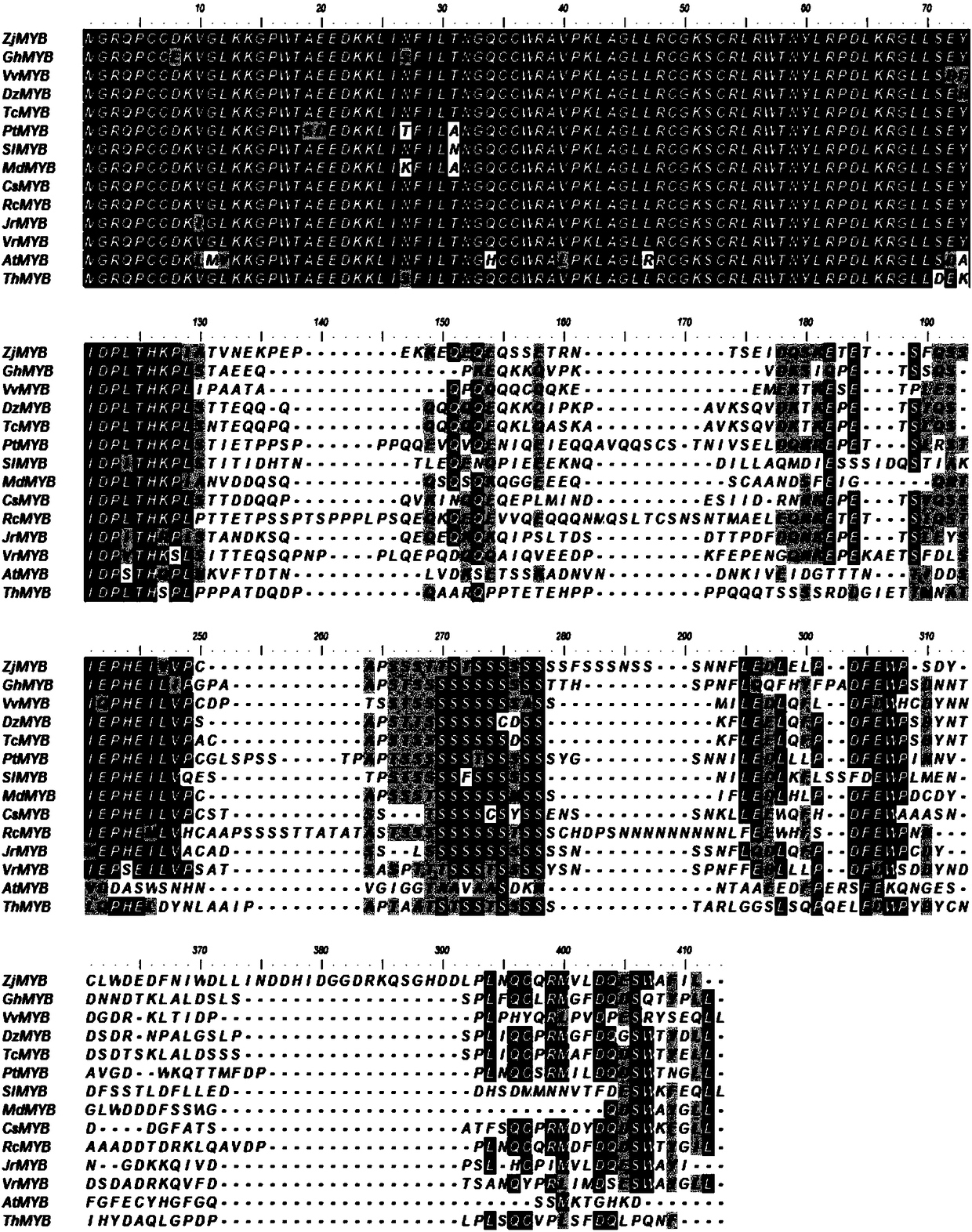Tamarix hispida MYB transcription factor coding gene and application thereof
A technology of tamarisk bristles and transcription factors, which can be applied in the fields of application, genetic engineering, and plant genetic improvement, and can solve problems such as inability to deeply understand the mechanism of salt tolerance
- Summary
- Abstract
- Description
- Claims
- Application Information
AI Technical Summary
Problems solved by technology
Method used
Image
Examples
Embodiment 1
[0035] Example 1: Cloning, bioinformatics analysis and domain verification of the ThMYB gene of Tamarix bristles
[0036] 1. Cloning of the ThMYB gene of Tamarix bristles
[0037] 1.1 Extraction of total RNA from Tamarix brix
[0038] Seeds of Tamarix briatus were sown in artificial soil with a ratio of carbon soil to sand of 2:1, placed in a relative humidity of 65–75%, and a light intensity of 400 μmol m -2 ·s -1 , the average temperature is 22 ± 2 ° C greenhouse growth. After 2 months of growth, use 0.3mol·L -1 NaHCO 3 The roots were irrigated with the solution for stress treatment. After 0h (before stress treatment), 12h, 24h and 48h of treatment, the leaves and roots were taken and put into liquid nitrogen for quick freezing for RNA extraction. The CTAB method was used to extract RNA in each treatment period, and the extracted RNA samples were sent to Shenzhen Huada Gene Technology Co., Ltd. for the construction and sequencing of the transcriptome library.
[0039] ...
Embodiment 2
[0058] Embodiment 2: Construct the overexpression vector of Tamarix bristly ThMYB gene
[0059] According to the multiple cloning site of the plant overexpression vector pROKII and the characteristics of the ThMYB gene, the XbaI and KpnI restriction endonuclease sites were introduced into the 5' end and the 3' end of the ThMYB gene respectively, such as SEQ ID NO: 9 and SEQ ID The gene-specific upstream and downstream primers pROKⅡ-ThMYB-F and pROKⅡ-ThMYB-R indicated by NO: 10 were used to clone the ThMYB gene by RT-PCR using Tamarix cDNA as a template.
[0060] The RT-PCR reaction system was 20 μL, including 2 μL template, 1 μL each of pROKⅡ-ThMYB-F and pROKⅡ-ThMYB-R specific primers (10 μmol / L), 0.4 μL dNTP Mix (10 mmol / L), 10× LA Taq PCR buffer 2.0μL, LA Taq (5U / μL) 0.25μL. The reaction program was pre-denaturation at 94°C for 3 min; denaturation at 94°C for 30 s, annealing at 58°C for 30 s, extension at 72°C for 1 min, and 35 cycles; extension at 72°C for 7 min.
[0061]...
Embodiment 3
[0068] Example 3: Transient transformation of Tamarix bristles ThMYB gene
[0069] In this example, the overexpression vector pROKII-ThMYB (OE) constructed in Example 2 and the suppressed expression vector pFGC5941-ThMYB (SE) constructed in Comparative Example 1 were transformed into Tamarix bristles by using the transient transformation technique, so that the ThMYB gene can be transiently overexpress or suppress expression. At the same time, the empty pROKII vector was transformed into Tamarix brix as a control (CON).
[0070] The specific method is as follows:
[0071] 1. Select Tamarix bristles tissue-cultured seedlings subcultured for 30-35 days, with a plant height of 2.5-3.0 cm, and put the selected Tamarix bristles tissue-cultured seedlings into the high-osmotic treatment solution to soak for 5-10 minutes;
[0072] 2. Rapidly transfer the T. tumefaciens tissue culture seedlings treated with hypertonicity in step 1 to the infection solution containing the Agrobacterium t...
PUM
 Login to View More
Login to View More Abstract
Description
Claims
Application Information
 Login to View More
Login to View More - R&D
- Intellectual Property
- Life Sciences
- Materials
- Tech Scout
- Unparalleled Data Quality
- Higher Quality Content
- 60% Fewer Hallucinations
Browse by: Latest US Patents, China's latest patents, Technical Efficacy Thesaurus, Application Domain, Technology Topic, Popular Technical Reports.
© 2025 PatSnap. All rights reserved.Legal|Privacy policy|Modern Slavery Act Transparency Statement|Sitemap|About US| Contact US: help@patsnap.com



